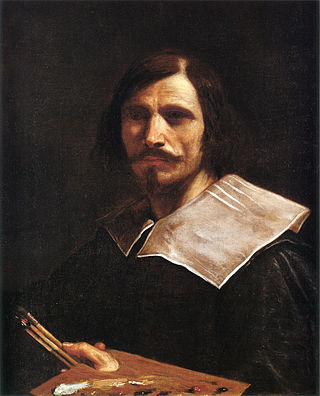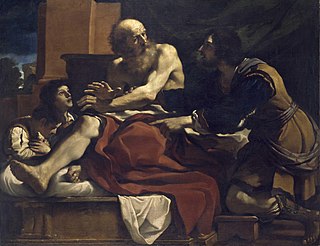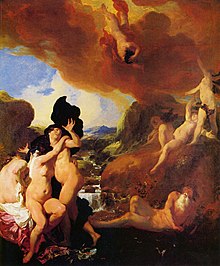
Giovanni Francesco Barbieri, better known as (il) Guercino, was an Italian Baroque painter and draftsman from Cento in the Emilia region, who was active in Rome and Bologna. The vigorous naturalism of his early manner contrasts with the classical equilibrium of his later works. His many drawings are noted for their luminosity and lively style.

Annibale Carracci was an Italian painter and instructor, active in Bologna and later in Rome. Along with his brother and cousin, Annibale was one of the progenitors, if not founders of a leading strand of the Baroque style, borrowing from styles from both north and south of their native city, and aspiring for a return to classical monumentality, but adding a more vital dynamism. Painters working under Annibale at the gallery of the Palazzo Farnese would be highly influential in Roman painting for decades.

Guido Reni was an Italian painter of the Baroque period, although his works showed a classical manner, similar to Simon Vouet, Nicolas Poussin, and Philippe de Champaigne. He painted primarily religious works, but also mythological and allegorical subjects. Active in Rome, Naples, and his native Bologna, he became the dominant figure in the Bolognese School that emerged under the influence of the Carracci.

Giacomo Cavedone (1577–1660) was an Italian Baroque painter of the Bolognese School.

The National Gallery of Ireland houses the national collection of Irish and European art. It is located in the centre of Dublin with one entrance on Merrion Square, beside Leinster House, and another on Clare Street. It was founded in 1854 and opened its doors ten years later. The gallery has an extensive, representative collection of Irish paintings and is also notable for its Italian Baroque and Dutch masters painting. The current director is Caroline Campbell.

The Taking of Christ is a painting, of the arrest of Jesus, by the Italian Baroque master Michelangelo Merisi da Caravaggio. Originally commissioned by the Roman nobleman Ciriaco Mattei in 1602, it is housed in the National Gallery of Ireland, Dublin.

The Cardsharps is a painting by the Italian Baroque artist Michelangelo Merisi da Caravaggio. The original is generally agreed to be the work acquired by the Kimbell Art Museum in 1987, although Caravaggio may have painted more than one version.

The Incredulity of Saint Thomas is a painting of the subject of the same name. It is one of the most famous paintings by the Italian Baroque master Caravaggio, c. 1601-1602. There are two autograph versions of Caravaggio's The Incredulity of Saint Thomas, an ecclesiastical "Trieste" version for Girolamo Mattei which is now in a private collection and a secular "Potsdam" version for Vincenzo Giustiniani that later entered the Royal Collection of Prussia, survived the Second World War unscathed, and can now be admired in the Palais at Sanssouci, Potsdam.

Mattia Preti was an Italian Baroque artist who worked in Italy and Malta. He was appointed a Member of the Order of Saint John.

Clovis Whitfield is an art historian and art dealer based in London, where he runs Whitfield Fine Art. He is a member of the Society of London Art Dealers.
Michael William Lely Kitson was a British art historian who became an international authority on the work of the painter Claude Lorrain.
Luigi Salerno (1924–1992) was an Italian historian of Italian art and historiographer. He is particularly known as a scholar of the Italian baroque and Salvator Rosa, with expertise on the 17th century, including Guercino and Caravaggio.

The Rape of Europa is a painting commissioned by Władysław IV Vasa from the Italian artist Guido Reni, completed between 1637 and 1639 and showing the abduction of Europa by Zeus in the form of a bull. It was later collected by Denis Mahon, who loaned it to the National Gallery, to which it was presented in 2013 by the Trustees of Sir Denis Mahon's Charitable Trust through the Art Fund.

Giovanni Battista Agucchi was an Italian churchman, Papal diplomat and writer on art theory. He was the nephew and brother of cardinals, and might have been one himself if he had lived longer. He served as secretary to the Papal Secretary of State, then the Pope himself, on whose death Agucchi was made a titular bishop and appointed as nuncio to Venice. He was an important figure in Roman art circles when he was in the city, promoting fellow-Bolognese artists, and was close to Domenichino in particular. As an art theorist he was rediscovered in the 20th century as having first expressed many of the views better known from the writings of Gian Pietro Bellori a generation later. He was also an amateur astronomer who corresponded with Galileo.
Gabriele Maria Finaldi is a British art historian and curator. Since August 2015, he has been director of the National Gallery in London, England.

Esther Before Ahasuerus is a painting by the 17th-century Italian artist Artemisia Gentileschi. It shows the biblical heroine Esther going before Ahasuerus to beg him to spare her people. The painting is now in the Metropolitan Museum of Art in New York, having been donated to the museum by Elinor Dorrance Ingersoll in 1969. It is one of Gentileschi's lesser known works, but her use of lighting, characterization, and style help in successfully portraying Esther as a biblical heroine as well as the main protagonist of the work.

Francesca Cappelletti is an Italian art history professor known for verifying the authenticity of the Caravaggio painting The Taking of Christ with Laura Testa while they were students at the University of Rome.

Portrait of Monsignor Giovanni Battista Agucchi is a 1604 oil-on-canvas painting now in York Art Gallery, to which it was presented via the National Art Collections Fund in 1955 by Francis Denis Lycett Green (1893–1959), a collector and younger brother of Sir Edward Arthur Lycett Green, 3rd Baronet. Long attributed to Domenichino, it is now usually attributed to Annibale Carracci, though some art historians still support the old attribution based on archival discoveries. The Gallery accepts the new attribution, though this is not yet reflected in its ArtUK entry.

Saint Matthew and the Angel is a 1621–1622 oil-on-canvas painting, produced by the Italian Baroque artist Guercino during his early years in Rome and now in the Musei Capitolini in Rome.

Jacob Blessing the Sons of Joseph is an oil-on-canvas painting created ca. 1620 by the Italian Baroque artist Guercino, now in the National Gallery of Ireland. It depicts the Biblical story of Jacob blessing his grandsons Manasseh and Ephraim, with the boys' father Joseph on the right protesting that the primary right-handed blessing has been given to the second-born (Ephraim) not first-born (Manasseh) son.


















